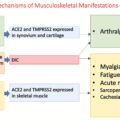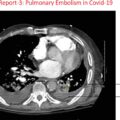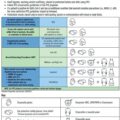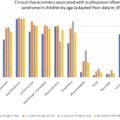OUTLINE
Epidemiology of Neurological Manifestations of COVID-19, 159
Historical Background of Neurological Effects of the Coronavirus Family, 160
Pathophysiology, Pathogenesis, and Proposed Mechanisms of the SARS-CoV-2 Virus and the Nervous System, 161
COVID-19 and the Peripheral Nervous System, 162
COVID-19 and the Central Nervous System, 166
Encephalopathy and Encephalitis, 166
Transverse Myelitis, 166
Seizures, 166
Cerebrovascular Disease, 166
Case Example: 7.1 Encephalitis, 167
Case Example: 7.2 Transverse Myelitis, 168
Long COVID and Neurological Postacute Sequelae of SARS-CoV-2 Infection, 169
COVID 19 and Challenges, 169
Summary, 169
Epidemiology of Neurological Manifestations of COVID-19
SARS-CoV-2, the causative virus of coronavirus 2019 (COVID-19) disease, initially emerged in the Wuhan region of China and rapidly spread worldwide. The exact origins of SARS-CoV-2 are unknown, but a nonhuman origin similar to that of the other human coronaviruses, that is, the Middle East respiratory syndrome coronavirus (MERS-CoV) and severe acute respiratory syndrome coronavirus-1 (SARS-CoV-1), is considered to be the most likely scenario. The index cases in Wuhan were all associated with the Huanan Seafood Wholesale Market, which is a place where live animals and seafood are sold. Animal-to-human and human-to-human spread by respiratory droplet is thought to be the most likely cause and transmission route.
SARS-CoV-2 is an RNA virus belonging to the family Coronaviridae, which is classified into four genera: α-coronavirus, β-coronavirus, γ-coronavirus, and δ-coronavirus. The α-coronavirus and β-coronavirus genera only infect mammals. The β-coronavirus group includes several human pathogenic viruses previously associated with smaller outbreaks in the years preceding 2019. Before December 2019, there were six coronaviruses known to infect humans with varying severity ranging from mild upper respiratory tract symptoms to more pathogenic strains (MERS-CoV and SARS-CoV-1) that have caused pandemics, albeit on a smaller scale compared with SARS-CoV-2 over the last two decades. As of May 2022, the World Health Organization (WHO) has reported more than 500 million cases of SARS-CoV-2 globally and more than 6 million COVID-19 related deaths. Human coronaviruses have been historically associated with respiratory symptoms and fever related to pneumonia or upper respiratory tract infection. Less frequently reported symptoms include gastrointestinal and cardiovascular symptoms, but this family of viruses can also have direct and indirect effects on the central and peripheral nervous systems leading to neurological sequelae. ,
COVID-19 first gained attention as a pulmonary illness featuring mild to moderate cough, fever, and malaise. The initial reports of the incubation period of SARS-CoV-2 varied between 3 and 7 days, and best estimates now have suggested a range from 2 to 14 days for the viral incubation period. ,
In some patients there is a rapid immunogenic response that leads to worsening hypoxemic respiratory failure that in mild to moderate cases requires the support of low-flow oxygen therapy and non-invasive ventilatory support. In about 10% of cases the severity progresses to acute respiratory distress syndrome (ARDS) requiring intensive care unit (ICU) admission, invasive mechanical ventilation and advanced therapies for respiratory support, including prone positioning and extracorporeal membrane oxygenation (ECMO) as well as immunomodulatory therapy. The most severe cases of COVID-19 were also complicated by hypercoagulability leading to venous thromboembolism and disseminated intravascular coagulation (DIC) and multiorgan failure; including acute renal and liver failure. Patients at higher risk for this increased severity of disease were noted to be of older age and male sex. A population study based on public health data in a Chinese population noted that the risk for symptomatic infection increased with age, and patients above 59 years of age were 5.1 times more likely to die after developing symptoms compared with those patients between 30 and 59 years of age. , A prospective observational study of European patients with COVID-19 in early 2020 during the peak of the pandemic found that the average age of patients admitted to the intensive care unit (ICU) was 63 years and the average age of the ICU nonsurvivors was 71 years. Overall, in this cohort the patients with more severe disease were older, men, and had at least one co-morbid medical illness including essential hypertension, diabetes mellitus, ischemic heart disease and/or chronic pulmonary illness. Additional demographic groups that have shown a trend toward increased severity of disease include those who were obese, immunosuppressed, or pregnant.
As COVID-19 cases accumulated worldwide, reports of associated neurological symptoms emerged from several centers around the world. A retrospective case series from Wuhan, China reported 45.5% of patients with severe COVID-19 disease had neurological symptoms, including acute cerebrovascular disease, acute encephalopathy, and skeletal muscle symptoms. An analysis of nearly 4000 hospitalized COVID-19 patients from both the United States and Europe found that approximately 80% experienced some form of neurological symptom, most commonly encephalopathy, headache, ageusia, anosmia, coma, and/or stroke. Additional neurological symptoms, including delirium, dizziness, and headaches, have been reported with other coronavirus infections prior to the SARS-CoV-2 outbreak. ,
The neurological manifestations associated with SARS-CoV-2 infection range in severity. A few of the symptoms, such as myopathy, delirium, and encephalopathy, are the consequence of critical illness; however, some short- and longer-term peripheral and CNS manifestations may be related to the effect of the virus on the endothelium, direct neuronal invasion, and cytokine storming. A narrative review of neurological symptoms associated with SARS-CoV-2 infection delineated a prevalence ranging from 4.3% to 73% in a total of 2533 hospitalized patients with COVID-19. The most common neurological symptoms were myalgia (32.4%), headache (20.4%), and impaired consciousness or encephalopathy (21.3%). A cohort study of 3744 patients in two large global consortia reported that approximately 80% of patients hospitalized with COVID-19 were documented to have neurological symptoms with headache and anosmia being the most common self-reported symptoms. Nearly 40% of the central nervous system (CNS) conditions were described as nonspecific encephalopathies, with a smaller proportion of postinfectious and parainfectious syndromes, including encephalitis, acute necrotizing encephalopathy, acute transverse myelitis, and acute demyelinating encephalomyelitis. Cerebrovascular diseases, including both ischemic and hemorrhagic strokes, cerebral venous thrombosis, and posterior reversible encephalopathy (PRES), were another category of common CNS conditions described in hospitalized patients with COVID-19. Peripheral nervous system syndromes included classic sensorimotor Guillain-Barré syndrome (GBS) and associated variants including Miller-Fischer syndrome, axonal, pure motor or sensory and pharyngeal-cervical-brachial forms. , Critical illness neuropathy and myopathy have also been described as neurological symptoms of SARS-CoV-2 infection however they are related to prolonged ICU hospitalization and mechanical ventilation rather than a direct viral neurotropic effect. Anosmia and ageusia are among the most commonly reported peripheral nervous symptoms. These symptoms have been previously described in other human coronavirus infections, typically as part of their symptomatic phase or as postacute sequelae, but in SARS-CoV-2 infection these symptoms were prominent in otherwise asymptomatic persons or as the initial manifestation of COVID-19 disease. , , ,
The end result is that the neurological symptoms of COVID-19 can have both acute consequences affecting morbidity and mortality and chronic consequences for patients who are recovering, which ultimately affects their quality of life.
Historical Background of Neurological Effects of the Coronavirus Family
Human coronaviruses are a family of single-stranded, non-segmented, enveloped RNA viruses that contains seven unique strains, including SARS-CoV, MERS-CoV, and SARS-CoV-2. Human coronaviruses have demonstrated CNS tropism in vitro (cell cultures) and in vivo (animal) studies. In vitro studies have shown that human coronavirus strains can infect multiple types of neural cell cultures, including neuroblastoma, neuroglioma, and astrocytoma and microglial and oligodendrocytic cell lines. The potential for neuroinvasion by human coronaviruses has been demonstrated incidentally in brain autopsy samples from multiple sclerosis patients which showed a higher prevalence of coronavirus compared with other diseases and normal controls. Additionally, the detection of viral RNA in human brain autopsy samples from patients with human coronavirus supports their neurotropic and neuroinvasive properties. Postmortem studies of SARS-CoV-1 patients demonstrated viral particles within multiple regions of the brain—thalamus, cerebrum, brainstem, hypothalamus; however, in both animal and human studies, viral particles were not found in cerebellar tissue. MERS-CoV invasion into neuronal tissue was noted to be highest in the brainstem and thalamus. MERS-CoV patients had less direct evidence of neuroinvasion; however, several patients with severe disease manifestations developed altered consciousness, encephalopathy, seizures, ataxia, and focal neurological deficits with radiological changes on both computed tomography (CT) and brain magnetic resonance imaging (MRI) involving small vessels, including lacunar infarcts. , ,
In vivo studies of SARS-CoV-1 describe the proliferation of proinflammatory cytokines that are active in promoting blood–brain barrier breakdown, namely interleukin-8 (IL-8) and monocyte chemoattractant protein-1 (MCP1). ,
MCP1 is a proinflammatory mediator that is expressed in CNS cells, including astrocytes, neurons, and microglia. MCP1 may be upregulated in conditions that target and degrade the blood–brain barrier and can recruit additional inflammatory cells. , The proinflammatory effects of the human coronaviruses were also initially described in autopsy reports, including one that describes high serum levels of monokine induced by gamma interferon (Mig), also kown as CXCL-9 chemokine, in SARS-CoV-1 patients that was associated with neural invasion. SARS-CoV-1 neural invasion induced expression of Mig chemokine in gliocytes, leading to attraction of CD68 monocytes and CD3+ T-lymphocytes to sites of virus infection. The resultant systemic inflammatory cascade is one of the contributors to direct brain tissue injury. , This neuronal injury is then manifested in acute and ultimately chronic neurological symptoms known to be associated with human coronavirus infections.
Headache, dizziness, encephalopathy, meningoencephalitis, stroke, seizures, and neuromuscular weaknesses have been described extensively in the literature as both acute and at times as prodromal symptoms associated with SARS-CoV-2 infection. Many of these symptoms were also reported in the postinfectious period, with some symptoms such as headache, dizziness, encephalopathy, and neuropathy persisting for weeks to months after acute illness. , , , Neurological symptoms associated with SARS-CoV-2 were initially described in the acute period of infection and illness. However, as more time has elapsed the neurological symptoms in the postacute and recovery periods have been described as persisting months after resolution of the acute illness; this is now referred to as postacute sequelae of SARS-CoV-2 infection—neuro-PASC.
Pathophysiology, Pathogenesis, and Proposed Mechanisms of the SARS-CoV-2 Virus and the Nervous System
Neuropathological findings were noted in SARS-CoV-2 patients in the latter part of 2020 once autopsy studies were made available. Findings in some of these studies substantiated the potential for a direct neurotropic and neuroinvasive mechanism of action to the disease process. The spike (S) protein on the cell membrane of SARS-CoV-2 is considered to be a key to the virus’s ability to invade and modulate the nervous system. , , Several routes of viral entry into the CNS were theorized, mainly through hematogenous and transneuronal spread. , A unique mechanism for SARS-CoV-2 neuronal transmission proposed that the acquisition of the viral particles through the olfactory receptor neurons was possible by the olfactory nerve, which acted as a conduit to allow movement across the cribriform plate of the ethmoid bone after initial infection in the nasal passages and upper respiratory tract epithelium, leading to the initial symptoms of anosmia and ageusia. The direct invasion by the olfactory nerve was theorized to lead to cerebral invasion and hippocampal and brainstem spread. ,
The hematogenous route is another mechanism of direct neuronal invasion that has been described in SARS-CoV-2 infection. SARS-CoV-2, similar to other human coronaviruses, uses the S-protein on the viral cell membrane to bind angiotensin-converting enzyme-2 (ACE2) receptors located in various organs in order to access and enter host cells. , The ACE2 receptors are most notable in the respiratory epithelium of humans, but is also expressed strongly throughout the body, including in brain, heart, and adipose tissue, as well as throughout the vascular endothelium. Once bound, the virus undergoes fusion and endocytosis and then sheds its coat within the cell. Viral RNA is then translated, and viral particles are released from the host cells. In the CNS, ACE2 receptors are ubiquitous, especially in astrocytes, microglia, and oligodendrocytes. There are a number of neurons that also contain ACE2 receptors along the motor cortex, temporal regions, substantia nigra, thalamus, and olfactory bulb. Using the ACE2 receptors is one of the hypothesized mechanisms of direct neuronal effect by SARS-CoV-2. Additionally, it was postulated that SARS-CoV-2 could spread to the CNS in a manner similar to that of the human immunodeficiency virus (HIV), in which infected immune cells pass from the blood through the blood–brain barrier to infect the CNS. Once CNS penetration occurs, SARS-CoV-2 is thought to harm brain tissue directly by entering neuronal tissue using ACE2 entry and viral replication, or indirectly through immunogenic response.
Along with the direct neurotropic effects of SARS-CoV-2, the indirect effects of the virus leading to neuronal damage also have been described. These indirect effects on the nervous system are typically related to hypoxic brain injury, blood pressure dysregulation, severe metabolic disturbances, coagulopathy, and immune-mediated neurological damage. , , , , , , , Hypoxic-ischemic brain injury occurs as a consequence of the viral replication within pneumocytes, which leads to diffuse alveolar and interstitial inflammatory exudate and ultimately impairment of gas exchange; this is clinically manifested as pneumonia and in severe cases progression to ARDS. In addition to the severe clinical hypoxemic manifestations, COVID-19 patients have been reported to experience silent hypoxia at a prevalence as high as 20% to 40%. , The indirect effect of systemic hypoxemia in COVID-19 patients on the CNS have been described in both autopsy and radiological studies. A case series of postmortems performed on patients with COVID-19 who died of respiratory failure describes the presence of ischemic red neurons within the hippocampus and parahippocampal and cerebellar regions that are consistent with global ischemic injury. The brainstem of these patients also demonstrated reactive gliosis and microglia, which are reflective of hypoxic-ischemic injury that occurred directly before death. , , Although autopsy reports of hypoxic ischemic brain injury in COVID-19 patients are limited, additional information can be found in neuroimaging reports of MRI and CT patterns found in acutely ill COVID-19 patients, especially ones with prolonged ICU hospitalizations. Diffuse leukoencephalopathy has been described as symmetrical confluent white matter hyperintensities on T2-weighted sequences, as well as restricted diffusion on diffusion-weighted imaging. The observed pattern of leukoencephalopathy in these patients seem to spare the infratentorial and juxtacortical white matter and has been reported as both an acute phenomenon and a delayed posthypoxic event. Additional hypoxic-ischemic radiographic patterns on MRI have included symmetrical involvement of the basal ganglia. ,
Another indirect effect of SARS CoV-2 on the nervous system is mediated through the immunogenicity of the SARS-CoV-2 virus, which can cause a cytokine storm in a small percentage of individuals. This leads to the activation of a number of immune-mediated inflammatory pathways that eventually cause complement and coagulation cascade stimulation, disseminated intravascular coagulation, and ultimately multiorgan dysfunction. Additionally, the effect of SARS-CoV-2 on the vascular system through ACE2 receptors leads to blood pressure dysregulation, which may be manifested as hypertension and in addition to the coagulopathy increases the risk for both spontaneous intracerebral hemorrhage and ischemic stroke.
COVID-19 and the Peripheral Nervous System
Anosmia and Dysgeusia
During the early phase of the SARS-CoV-2 pandemic, in addition to respiratory symptoms, there were frequent reports of olfactory dysfunction with loss of smell (anosmia/hyposmia) or altered sensations of taste (dysgeusia). These anecdotal reports included both published and unpublished data in the early days of the pandemic. The reports became so common that the Centers for Disease Control and Prevention listed anosmia and ageusia/dysgeusia as a prodromal symptom of COVID-19. The British Association of Otorhinolaryngology and the American Academy of Otolaryngology-Head and Neck Surgery in 2020 both proposed that symptoms of olfactory and gustatory dysfunction be added to the screening lists for possible COVID-19 infection. , A systematic review and meta-analysis of patients with confirmed SARS-CoV-2 infection found that about 41% and 38% had olfactory or gustatory dysfunction, respectively, as their initial manifesting symptom. The onset was usually sudden and may precede other typical COVID-19 symptoms, and the olfactory or gustatory dysfunction lasted an average of 1 to 3 weeks, unlike other forms of postviral olfactory or gustatory dysfunction, caused by direct damage to the olfactory sensory neurons and therefore leading to a more common recovery timeline of months. ,
The mechanism leading to olfactory or gustatory dysfunction in COVID-19 is not fully elucidated; however, olfactory dysfunction is not uncommon as a postviral phenomenon of many other upper respiratory tract infections. Overall, postviral olfactory dysfunction occurs in at least 40% of patients with upper respiratory tract infections and approximately 10% to 15% of these olfactory or gustatory dysfunctions are caused by coronaviruses. , The olfactory or gustatory dysfunction symptoms in COVID-19 commonly arise in otherwise asymptomatic persons or as the prodromal symptom of COVID-19 rather than in conjunction with other typical upper respiratory tract symptoms (nasal congestion, sore throat), unlike other respiratory infections that cause olfactory or gustatory dysfunction. As discussed earlier, SARS-CoV-2 infects cells by binding its spike (S) protein with the ACE2 protein on the targeted cells. Based on this, the mechanism for olfactory or gustatory dysfunction in COVID-19 has been postulated to be related to the potential neurotrophic properties of SARS-CoV-2 leading to transneuronal spread through the olfactory nerve. However, these ACE2 receptors are expressed by nonneuronal supporting cells of the olfactory epithelium rather than directly within the olfactory neurons, casting doubt on the putative neurotropic mechanism of olfactory or gustatory dysfunction. , Although other neurotropic virus models have been able to demonstrate direct neuronal invasion by the olfactory nerve, pathological evidence to support this mechanism in SARS-CoV-2 infection is lacking.
Autopsies of patients with COVID-19 have found that the brain contains the lowest levels of SARS-CoV-2 compared with other organs. Animal models to investigate the mechanism of olfactory or gustatory dysfunction in SARS-CoV-2 have revealed variable results; one study of intranasal inoculation of SARS-CoV-2 in mouse models expressing human ACE2 receptors resulted in identification of the virus within the brain. Other models have demonstrated the presence of SARS-CoV-2 in the olfactory sensory support cells rather than the olfactory bulb, suggesting that the mechanism of olfactory or gustatory dysfunction is more of an inflammatory nature, which leads to faster recovery compared with other postviral olfactory or gustatory dysfunction. ,
MRI of the olfactory nerves can provide more details regarding the cause of olfactory dysfunction and predict recovery of olfactory function. A study using dedicated MRI of the olfactory nerves in patients with persistent olfactory or gustatory dysfunction related to COVID-19 after resolution of other symptoms was used to evaluate parameters, including olfactory cleft opacification, olfactory bulb volume, morphology, signal intensity, the architecture of olfactory nerve filia, and any signal abnormalities of the primary olfactory cortex. The majority of patients had opacification of the olfactory cleft (73.9%), and there were also changes in the morphology and T2 signal abnormalities of the olfactory bulb, along with decrease in the amount of olfactory nerve filia and objective reduction in olfactory bulb volume. The decreased amount of olfactory nerve filia resulting from clumping or loss of nerves suggest both inflammatory and degenerative loss as a result of SARS-CoV-2 infection. These structural changes potentially result in olfactory dysfunction from injury to the supporting cells of the olfactory epithelium. Another mechanism of olfactory or gustatory dysfunction is seen in the secondary inflammatory changes of the olfactory clefts that manifest as opacification on MRI of the olfactory nerves. Inflammatory changes are related to invasion of SARS-CoV-2 leading to mucosal edema and narrowing of the olfactory cleft; this hypothesis was supported in an imaging review showing olfactory cleft opacification in the majority of patients with COVID-19–related anosmia.
Although the mechanism of olfactory and gustatory dysfunction in patients with COVID-19 remains largely hypothetical, there has been overwhelming evidence using objective tests of smell and taste that anosmia/hyposmia and dysgeusia/ageusia are reliable prodromal symptoms of infection with SARS-CoV-2.
Guillain-Barré Syndrome and Associated Variants
Acute inflammatory demyelinating polyneuropathy (AIDP), more commonly known by its eponym Guillain-Barré syndrome (GBS), is an autoimmune disease in which an inciting event such as an infection (commonly bacterial or viral) or vaccination incites the production of autoantibodies by molecular mimicry leading to demyelination of peripheral nerves with subsequent ascending paresis/paralysis, sensory disturbances, and ophthalmoparesis and in severe cases diaphragmatic weakness and bulbar dysfunction requiring mechanical ventilation.
The mechanism of GBS as a parainfectious or postinfectious phenomenon of SARS-CoV-2 infection is postulated to be one of molecular mimicry. The production of autoantibodies through exposure of antigen epitopes and molecular mimicry in GBS may be related to the initial SARS-CoV-2 viral infection and resultant inflammatory cascade. SARS-CoV-2 epitopes have demonstrated cross-reactivity with autoantigens including heat shock proteins and proteins within the brainstem associated with GBS and respiratory failure respectively. In general, the increased proportion of serum inflammatory markers, including CRP, IL-6, IL-1, and tumor necrosis factor-alpha, in cases with GBS and COVID-19 seem to support the dysimmune theory. ,
As illustrated in Fig. 7.2 , antibodies are formed against SARS-CoV-2 and/or pathogens bind to gangliosides on the surface membranes of peripheral motor and sensory neurons and cause immune-mediated damage to the myelin sheath and/or axons. The SARS-CoV-2 infection is postulated then to trigger an adaptive immune response in which T-cell–B-cell interactions result in the production of SARS-CoV-2–specific antibodies, but a similarity in viral and ganglioside peptide sequences or structure can result in the development of autoimmunity. The Schwann cell ganglioside peptide sequences located on the myelin sheath of axons and membranes of neurons may act as receptors for these antiganglioside antibodies, which neutralizes the neurons’ complement inhibitory activity and turns them into targets for an autoimmune-mediated destruction of myelin sheaths or axons. Depending on the nature of the damage, an individual may experience either the demyelinating or axonal GBS subtype, which differ not only in symptom manifestations but also in likelihood of recovery.
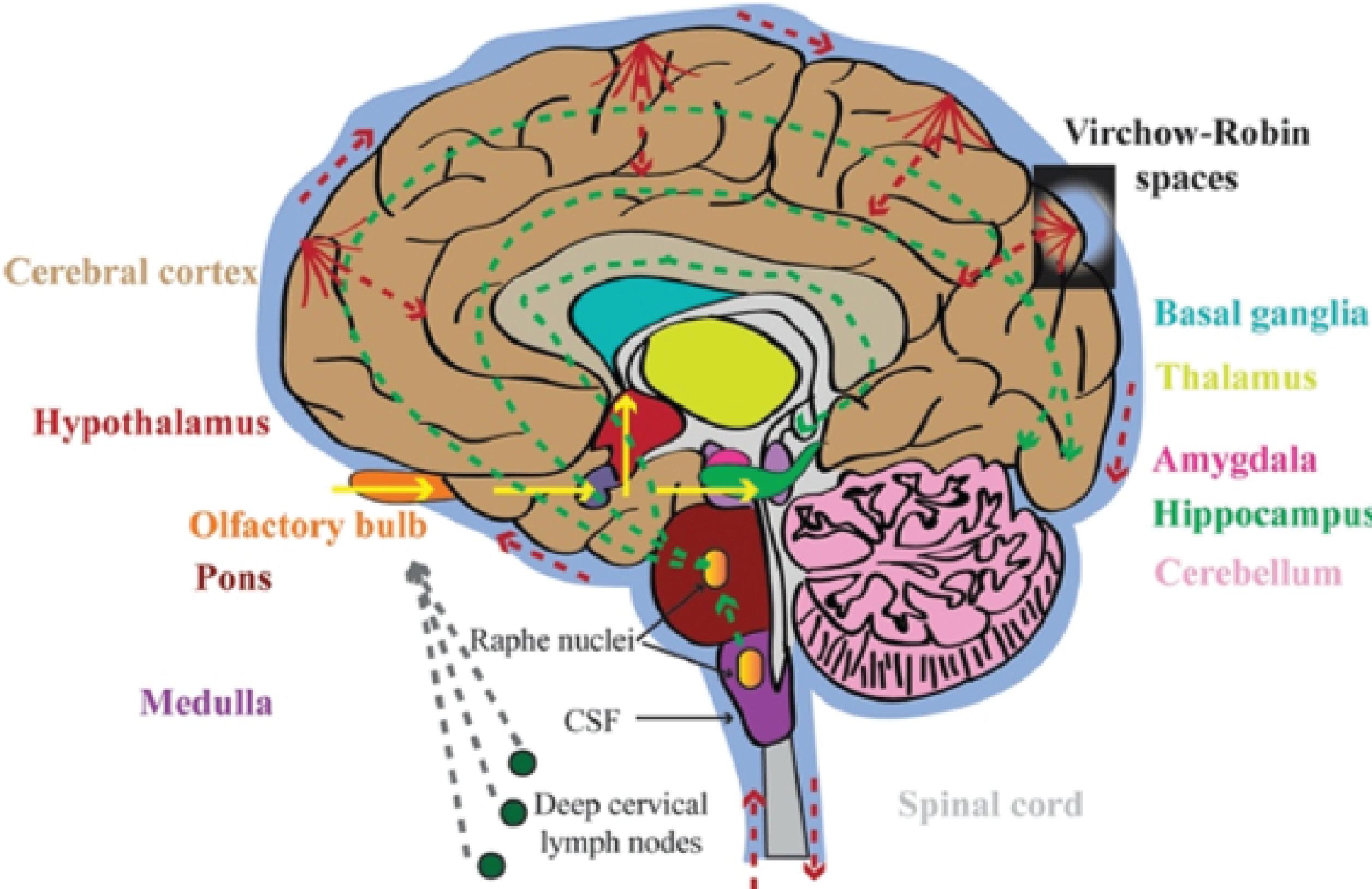

Stay updated, free articles. Join our Telegram channel

Full access? Get Clinical Tree





